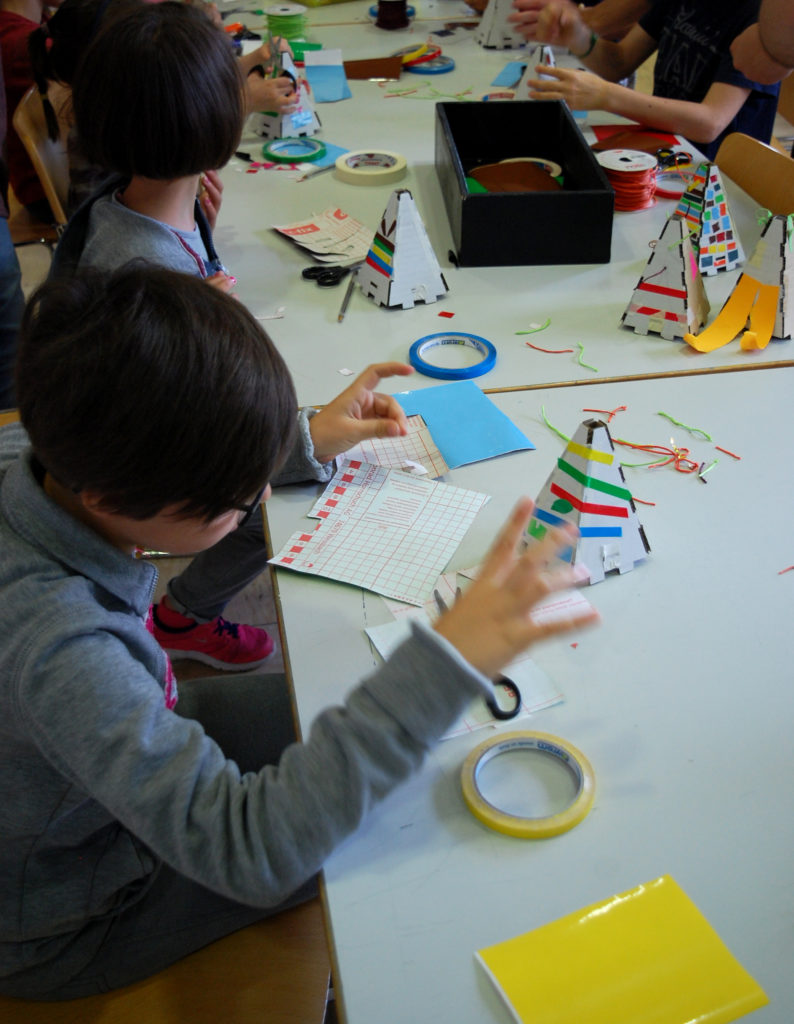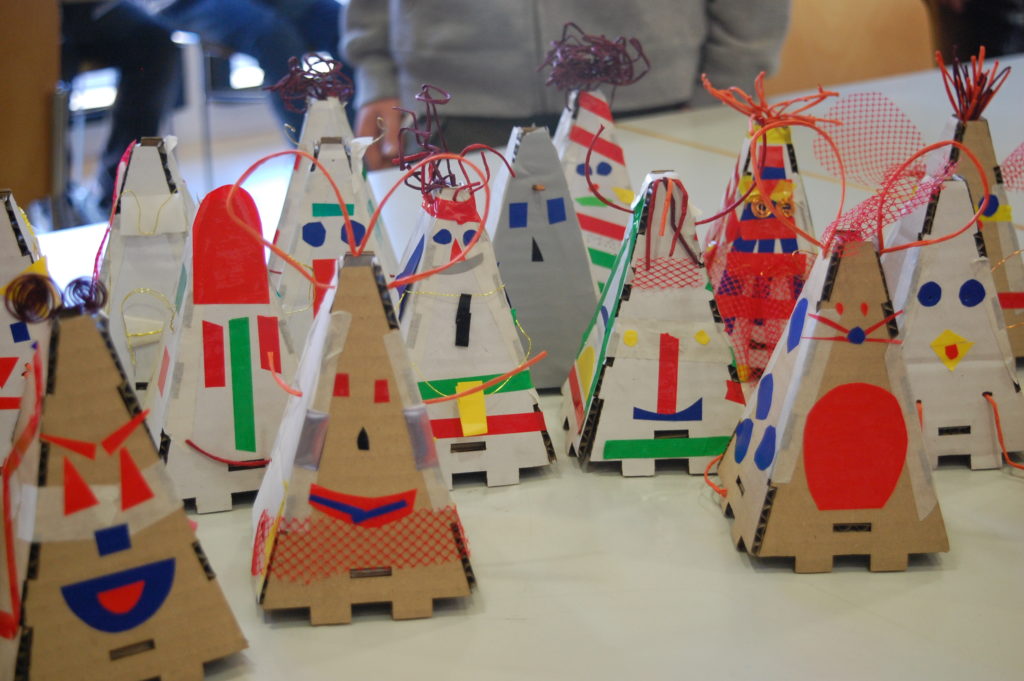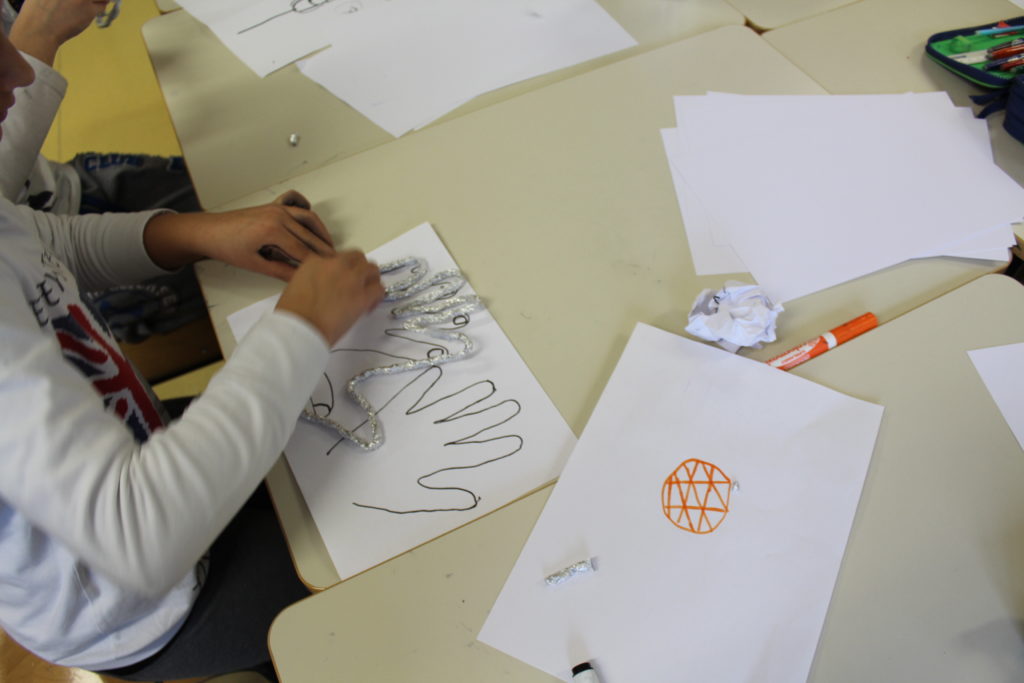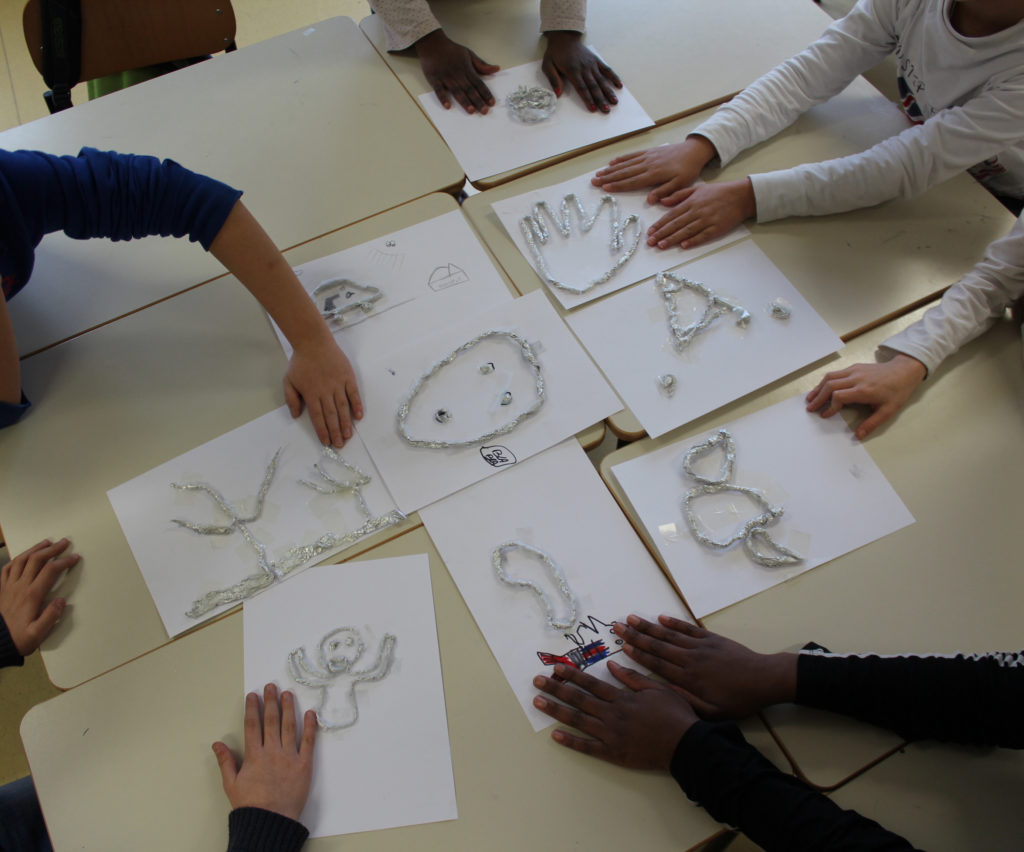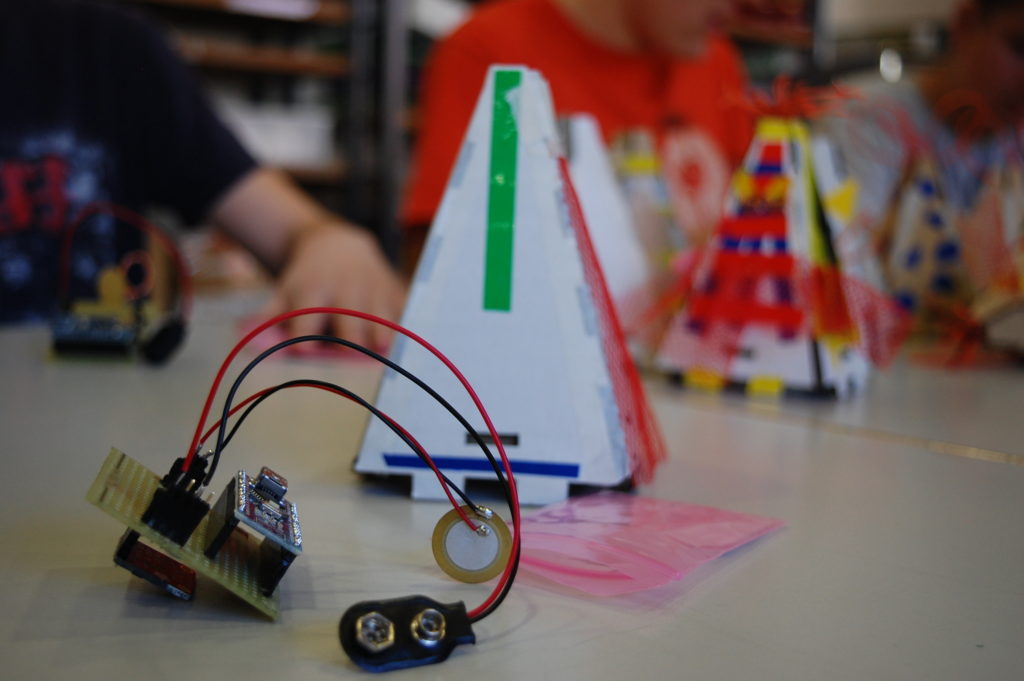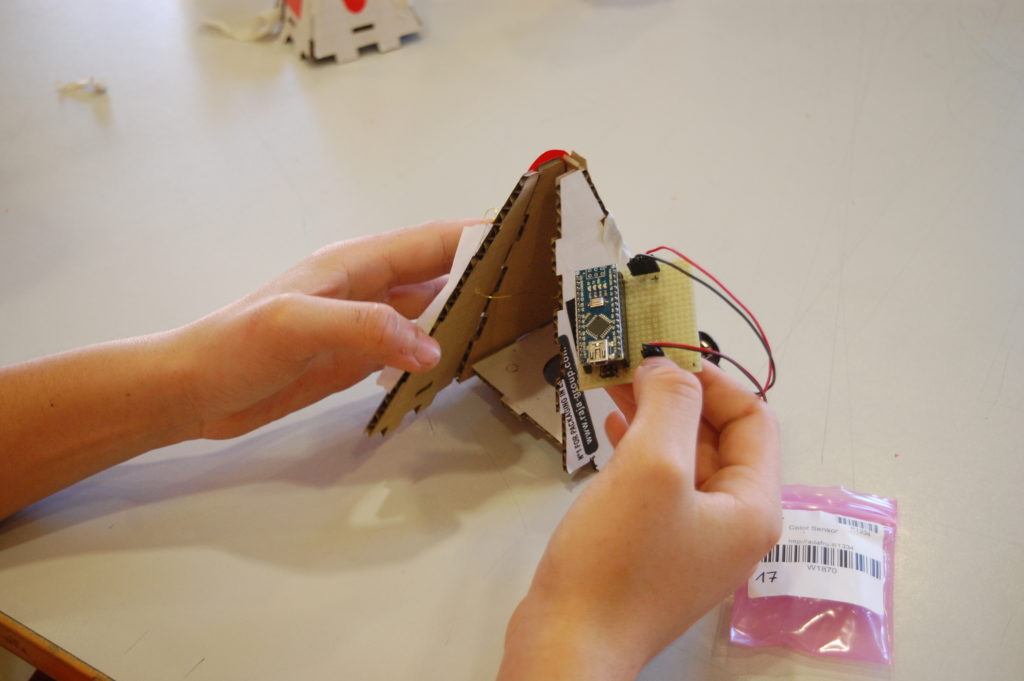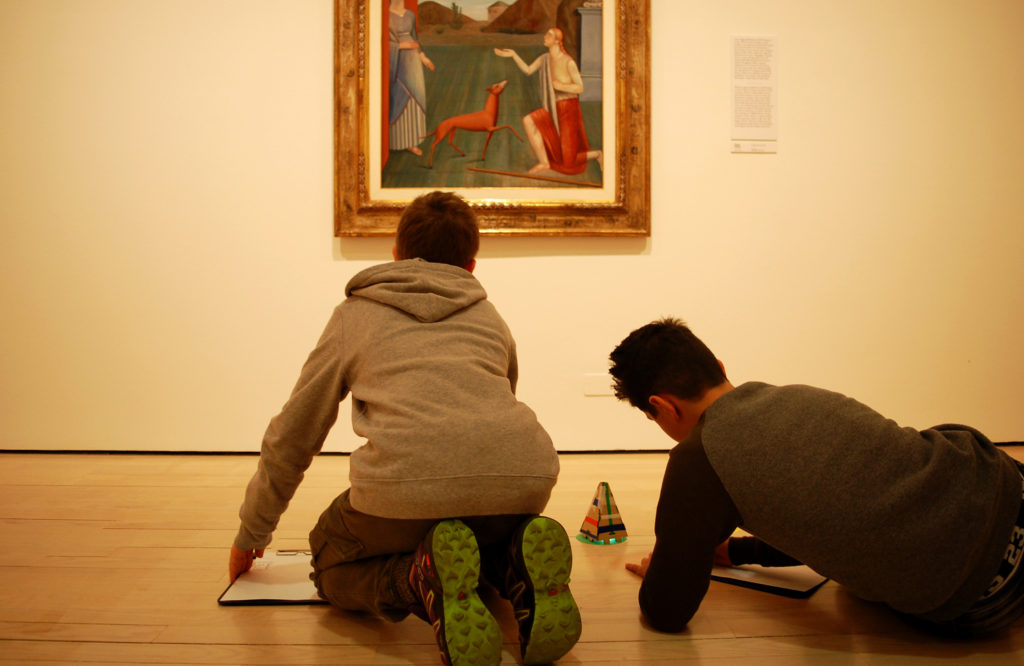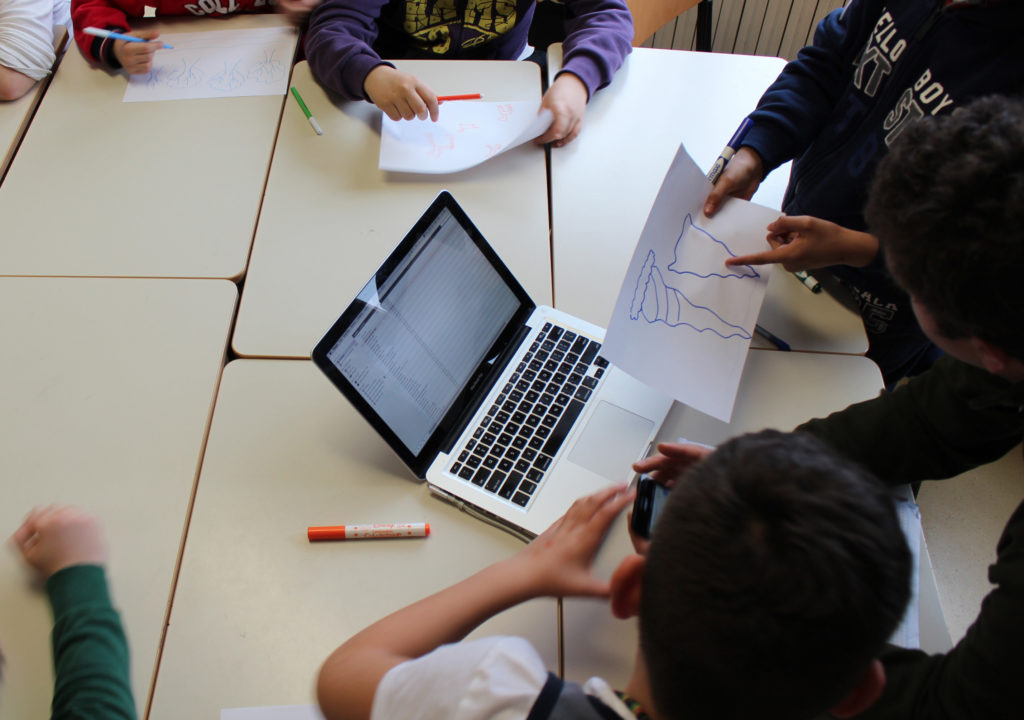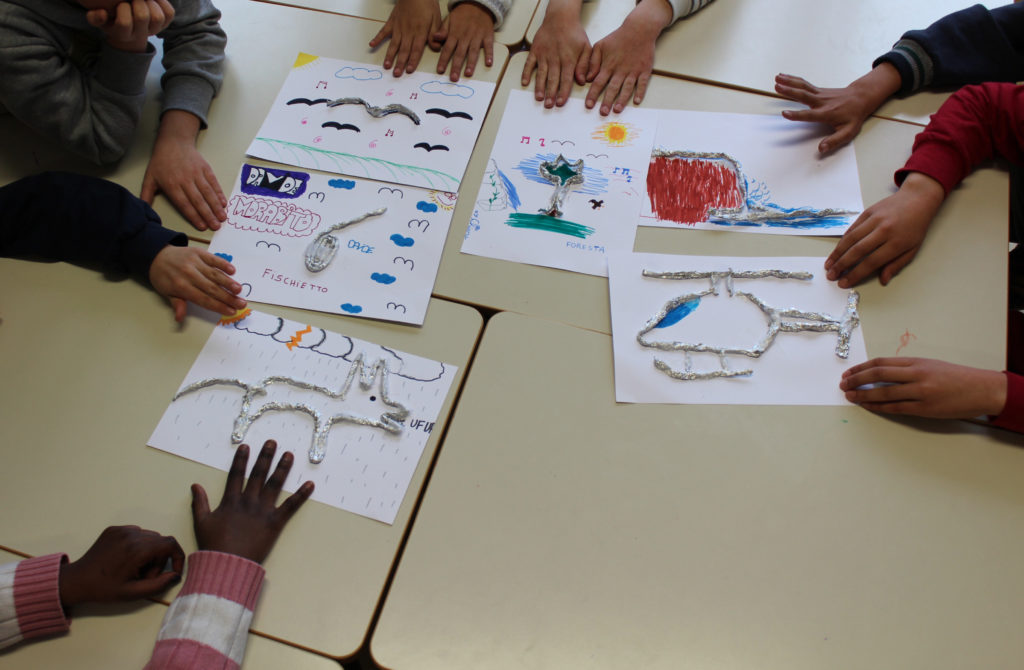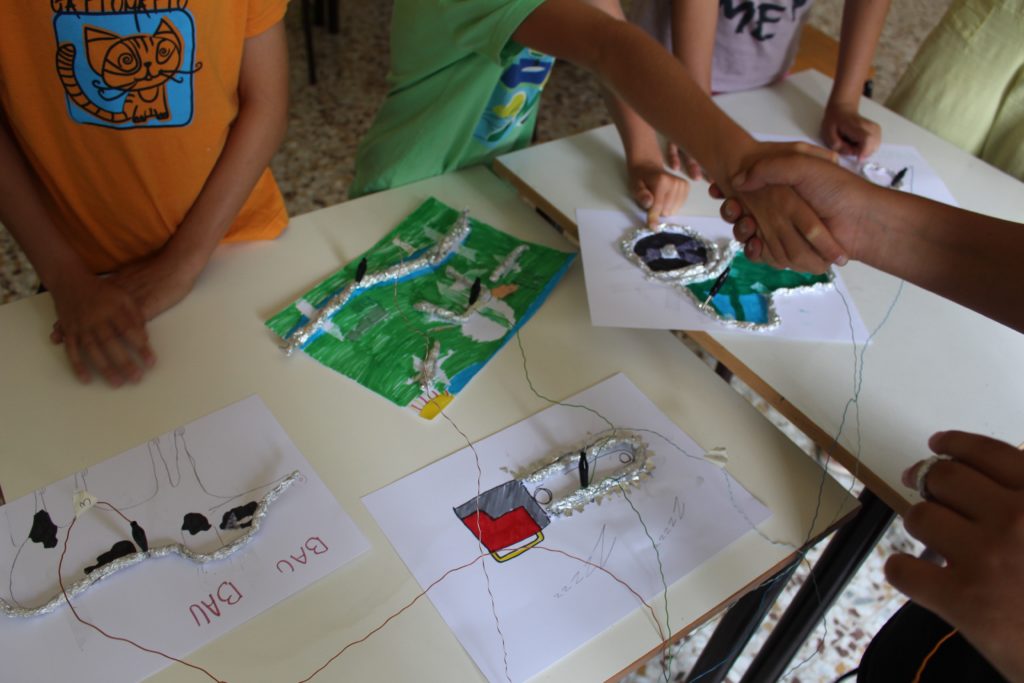Interview to Adriano Siesser, Museum mediator
2 Projects:
- Soundscapes (transversal for all ages, from pre-school to adults) within the cycle of meetings: “I, art and design” promoted by MART Museo di Arte Moderna e Contemporanea di Trento e Rovereto (Museum of Modern and Contemporary Art of Trento and Rovereto) and the University of Trento
- Bugbits (pyramids) 10-15 years
GENERAL SETTING
- 1 – How was this project born: from which needs? To answer which question?
Bugbits is born within a doctoral research at the University of Trento (conducted by Andrea Conci), creating tangible interfaces, to be touched, experimenting with Arduino. The experimentation became part of a workshop series at the MART Museum of Modern Art. The idea was to create a mix between play and aesthetics and to let the kids build their own interfaces – their own interaction with the work of art, trying to understand how to discover the museum in a playful matter – in case of bugbits – like a treasure hunt. Kids will make the bugs (cardbox piramids) with a programmed arduino card, that will follow a random track, which kids have to follow, stopping by surprise in front of an art work, with colored markings that the “bug” recognizes and thus stops (10 circles with 10 different colors – the bug becomes a kind of surprise guide.
The idea of Soundscapes is as in Bugbits to create new interfaces and interaction with the museum – in the case of Sound Landscapes, the interface is a drawing, which becomes an interface with the use of foil paper and arduino/ makey makey , to create a visual representation through sound. The idea is the approach to works of arts, to aesthetics using other senses – other than only the “eye”, developing at same time listening, critical listening – and to raise awareness on our sound patrimony. Objective of this experience is the sensitization to critical listening.
- 2 – What is in your opinion innovative on this project?
Innovative is the discourse on open technology – the link between the physical and the digital (drawing by hand – technology). To use the technology as a tool, a conductor, that leads the kids to see and hear differently, through play and the joy of discovery – approximating art through play, science and marvel. In the two projects the kids learn to handle the object using more senses – as also technology is used together with other tools in order to create “hands- on”, sonorous and visual experiences in order to see art works in the museum, not only from different “points of view” but also from other sensorial aspects. Together with arduino, makey makey, important materials are pens, glue, scissors, etc.
- 3 – Which are in your opinion the ICT competencies of adolescents that are important for your project?
And how are they valorized through your project? They have curiosity and explorative ability – they automatically touch to see what happens, they are familiar with the interaction with an interface, used to use a touch screen. During the experience, however, they realize and learn to comprehend what happens between interface and action. They bring competences in using the objects and with well-known materials and technologies which they use in their everyday life they learn to understand processes.
- 4 – What did your discover through the project that you didn’t expect or imagine?
The projects started very experimental, with very little expectations, but the way in which the kids positively welcomed this living the museum in a different way, was surprising. We didn’t expect so much positive feedback, a such an immersion in the experience from side of the kids. That they really comprehend technology as an additional tool (together with others) to approach art and the aesthetic in general.
- 5 – What is the link between your project, media competencies and active citizenship?
The objective is to create a critical approach to world in general, to art, to what is around you with the creative use of technology. For Soundscapes for example, kids are supposed to do a kind of sound diary, of every day sounds that are around them, bringing them to realize their environment through hearing and so enhancing perception of your environment using different senses. By creating interfaces that generate sound you undergo a critical and analytical process. Another aspect is the one of working in a group, to achieve something together for which you do not take credit as a single person but as a group – work within a community. In the case of Bugbits it is the sense of doing something that matters – as they are contributing for a university research – to belong to something “bigger”. The other aspect is the involvement of the families in the activities of the museum – you create so an open space of communication between museum and community.
EXPERIENCE REPORTING
- 1 – What happens during activities? Which working steps are asked from the students?
(Laboratories typically last 2 hours)
Bugbits
- 1st phase
Activity begins with welcome and presentations. Participants are shown some examples of interactive art, explaining their main features and commenting together. They are asked if they have ever had interactive experience in museums or other places, such as in museums of natural sciences, history, interactive exhibitions. It is then explained to them that they will create small interactive works that will guide them into a sort of treasure hunt within the museum halls; Sometimes we show them a specimen of Bugbits – in this case a pyramid – that they will build. - 2nd phase
Participants are introduced to the steps of the operational phase, explaining the various processes that will lead to the final stage of the activity. They are divided into pairs, then they are shown the materials they will use. They begin with the assembly of the main structure, then move on to the decorative phase and, finally, to the assembly of the electronic part. All electronic components are shown, explaining the function, and the steps to assemble them and insert them into their artifact. We explain them the operation of the pyramid “bug” and what they will have to do in the last phase. Once checked that everything works, they move into the museum halls. - 3rd phase
Participants are invited to use the pyramid bug as a guide to the museum, which leads them to look for colored cards that can make them react with sounds. The participants, once found a suitable color for their artifact, will wait so the one-minute sound cycle is completed; while waiting they are invited to describe, graphically or in words, details of the artwork they face. When the pyramid bug stops with the sound, the participants look for the next color and so on, until the last color is reached or the end of the time available. At the end of the activity, they get back to the lab to collect comments, impressions, and opinions.
Soundscapes
- 1st phase
Activity begins with welcome and presentations. Participants, if in a museum, are quickly brought to face landscapes and are asked if they know – or can imagine – what is a soundscape. They are then invited to express that sounds could be felt if it was possible to “enter” one of the paintings shown, stimulating their imagination, observation, and descriptive abilities; The activity is repeated for two or three images. They are then asked to make an exercise of greater abstraction, asking them to describe the sounds they hear in their everyday life (morning, breakfast, school, class, place where they love to spend more time) analyzing them together and introducing the concepts of keynote sounds, sound signal e soundmark, as formalized by Raymond Murray Schafer; we also discuss about the sounds that have disappeared and the centrality of the image in comparison to sound in the daily life, and then move to the lab. - 2nd phase
Participants are introduced to the steps of the operational phase, explaining the various processes that will lead to the final stage of the activity. They are divided into groups and invited to create a landscape to be described through the sounds. The mediator discusses with each group the ideas and guides the participants in selecting sounds from an archive. Each participant realizes a drawing representing the selected sound and adds a piece of foil to his work. - 3rd phase
Groups are invited to perform one at a time, showing their own work, explaining which soundscape they chose to describe and how, and finally linking their drawings to the system that allows them to play. Tapping on their own work they make sound compositions, trying one at a time, bringing them together, playing them all together, trying to identify and describe what is being heard. At the end of the show all groups discuss on what they have done, collecting comments, impressions and opinions.
- 2 – Which methodologies do you use?
In general we use an open sensory approach, give room to “tale of experiences”. The educator is a mediator for the experiences, although technology needs to be explained. After an introduction to interactive art, the teens start making, build themselves Art at all –
We seek to stimulate the individual creation of experience, the interpretation of reality by individual participants, in the field of museum teaching and cultural mediation.
3 – Which tools?
Soundscapes: Makey Makey/Arduino.
Bugbits: Arduino.
4 – Which materials?
Soundscapes: Various materials are used as cardboards, pens, scissors, glues, foil paper, reproductions, computers with audio system and interactive system.
Bugbits: Various materials, such as prefabricated cartons, pens, scissors, glues, colored cards and cards, colored iron wire, pencils, reproductions and electronic components are used.
- 5 – Which project choices do you consider strategic?
In Soundscapes as well as Bugbits, the interactive system is not a “closed box” but open and is explained to the participants. Although simple materials are used, interaction is not trivial and technology is not the central aspect, but it is as important as the other components. The interaction is shifted from a graphical interface to more concrete and familiar objects, in this case the elaboration is made by the participants.
The combination of science and art, made of discovery and wonder. They do not expect the drawings to work really.
In Soundscapes for example important is the contact, physical appearance of hand, touch, group work to create synesthesis. And the fact that they are contributing for a research, their value for something else and that their experiences mean something for something “bigger” is very involving.
- 6 – How do you arouse curiosity in the teenagers?
Soundscapes: Participants are introduced to the subject of soundscape, a curious and unknown topic, explaining to them that during their work they will create an elaborated work that will enable them to play(sound) their designs through an interactive installation activated by them. It is also explained to them that what they will do is partly the result of an university research path.
Bugbits: Participants are introduced to the theme of interactive art by showing them examples, explaining to them that during the activity they will come up with an artifact that will allow a “treasure hunt” in the museum. Sometimes you can see the work of an artifact that has already been completed, as you can imagine the fun aspect of the activity right away. It is also explained to them that what they will do is partly the result of a university research path.
- 7 – What do they learn?
Soundscape: the activity seeks to stimulate awareness of listening, more attention to the sounds that surround us and sound heritage, critical listening, the creation of sinesthesys, critical and descriptive ability, the ability to invent and compose, collaboration, interdisciplinarity, creativity, simple notions of physics and electronics.
Bugbits: They try to stimulate creativity, a multidisciplinary approach, observation skills, simple notions of electronics, descriptive abilities, exploratory abilities, awareness that the museum can also be lived in a playful and entertaining way, an open exploration and invention dynamic attitude.
-
- 8 – Which competences are developed and enhanced?
- Curiosity, exploration, and experimentation are developed
- Critical exploration
- Sensory skills
- Work in groups
- Scientific Skills: Physics, Electronics
- To go beyond “the like/ I do not like – nice / ugly” – critical analysis Description of the lived through all the senses
9 – Which are expected results and those effectively attained?
The approach is very experimental and there actually no expectations – but in general we could say that they are in line with our thoughts when designing the workshops.
- 10 – How do you evaluate this experience? Do you evaluate it at all?
Experience is evaluated with a direct comparison in the final stage of the activity, where comments, impressions and opinions are collected. For Bugbits there is an evaluation questionnaire with choice fields for the evaluation, as it is part of an ongoing research.
- 11 – When things don’t work out, how do you readapt activities?
The activities have always been carried out without major hiccups, with only minor modifications to suit the situation and the group of participants.
Initial part attracts a lot – when they understand the process, attention drops after the first group presents They are very sorry not to be able to bring the functional object with them – difficulty in understanding that what they bring home is the experience.
Tutte le immagini presenti in questo articolo sono per gentile concessione di Mart Archivio Fotografico
